Update 12/3/2025 – Simba is no longer available for purchase online in Canada. According to the Simba Canada website, Simba is still sold at Sleep Country. However, Sleep Country only appears to carry the Simba 2500 model.
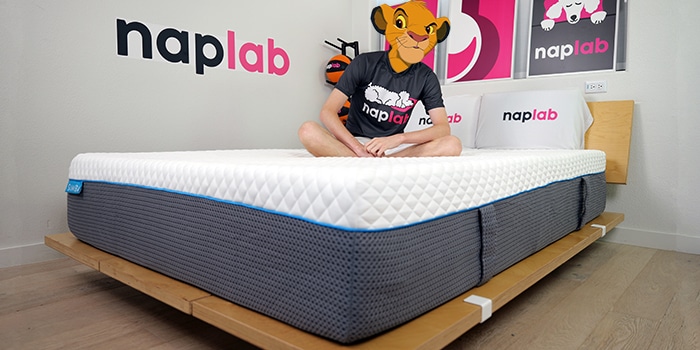
Best For
- Excellent pressure relief with 6.0″ comfort layer, suitable for all sleeping positions
- Microcoil layer helps improve cooling and breathability
- Good lying edge support
Considerations
- The mostly foam material construction means cooling is good, but far from great
- Poorer edge support when sitting on the edge of the mattress
- Below-average sex score due to lower bounce
Our Verdict
The Simba Hybrid Pro is a 13.5″ foam mattress that calls itself a hybrid. Unlike most hybrids, which typically have a coil base, the Simba Hybrid Pro has a blend of foam, microcoils, and a support foam base.
This mattress has very deep sinkage and low levels of bounce. A top layer of memory foam gives this mattress greater contour and hug.
The Hybrid Pro is available in a single firmness level, 5 out of 10, which gives the mattress a medium feel.
In our performance tests, the Simba had an overall score of 7.80, which is well below the average performance score of 8.55, based on all of our tests to date.
The mattress costs $1799 for a queen, 66% more than the average foam mattress (considering over 265+ mattresses tested to date).
Type: Foam
Firmness: Medium (5)
Best For: All Sleeping Positions, All Body Weights
In This Review
Performance Tests | Firmness | Support & Sleeping Positions | Design | Materials | Comparisons | FAQs
Performance Tests
At NapLab, we put each mattress to the test.
We test 10 different factors that impact the performance, comfort, and feel of the mattress. We then take the results of that test and compare to every mattress we’ve tested to date.
Check out the full performance table below to see how this mattress ranks:
| Factor | Simba Hybrid Pro | Average |
|---|---|---|
| Overall Score | 7.80 | 8.55 |
| Price (Queen) | $1,799 | $1,079 (Foam only) |
| Cooling – Score | 8.0 | 8.7 |
| Sinkage – Depth | 2.76″ | 2.15″ |
| Sinkage – Feel | Very Deep | Moderate |
| Motion Transfer – Score | 8.0 | 8.2 |
| Motion Transfer – Acceleration | 9.48 m/s² | 8.79 m/s² |
| Response Time – Score | 8.2 | 8.9 |
| Response Time – Mostly Recovered | 0.5 sec. | 0.4 sec. |
| Response Time – Fully Recovered | 0.8 sec. | 0.9 sec. |
| Bounce – Height | 7.53″ | 9.52″ |
| Bounce – Feel | Low | Moderate |
| Edge Support – Score | 7.5 | 8.6 |
| Edge Support – Sitting | 6.25″ | 4.05″ |
| Edge Support – Lying | Excellent | Good |
| Sex – Score | 7.2 | 8.4 |
| Pressure Relief – Score | 9.0 | 8.7 |
| Comfort Layer Thickness | 6.0″ | 4.1″ |
| Mattress Thickness | 13.5″ | 12.0″ |
| Off-Gassing – Score | 8.1 | 8.2 |
| Off-Gassing – Smell | Strong | Strong |
| Off-Gassing – Days | 7 days | 6 days |
| Company – Score | 5.0 | 8.8 |
| Trial | 100 nights | 178 nights |
| Warranty | 10 years | 25% have lifetime warranties, average of other 75% of mattresses is 13 years |
How is Simba Hybrid Pro Different?
According to the manufacturer, the Simba Hybrid Pro is a hybrid mattress. However, I would simply call this a foam mattress. While it does have a thin microcoil layer, its material components and design are far closer to those of an all-foam mattress than they are a hybrid mattress, in my view.
The mattress has a lower-than-average overall performance and a price tag that is higher than the average. Needless to say, this is not the balance we like to see.
Advantages
Looking at specific advantages, the Simba Hybrid Pro has excellent pressure relief and a thicker material profile. This mattress is 13.5″ thick and has a 6.0″ comfort layer. The average mattress we test is 12″ thick and has a 4.1″ comfort layer, so the Simba offers thicker layers.
Neutral Factors
This mattress has very deep sinkage and low levels of bounce. It has a more traditional memory foam feel with deeper contour and slightly slower material response time.
Motion transfer was slightly worse than average, but nothing hugely problematic.
Disadvantages
Disadvantages of the Simba Hybrid Pro include poorer cooling performance and slower material response time, as mentioned above. Edge support also struggles a bit when seated right at the edge of the mattress. Lying edge support was excellent.
Lastly, the Simba has a trial and warranty that are both shorter than average. To add to the disappointment, they only accept exchanges and it will cost you $99 to make an exchange.
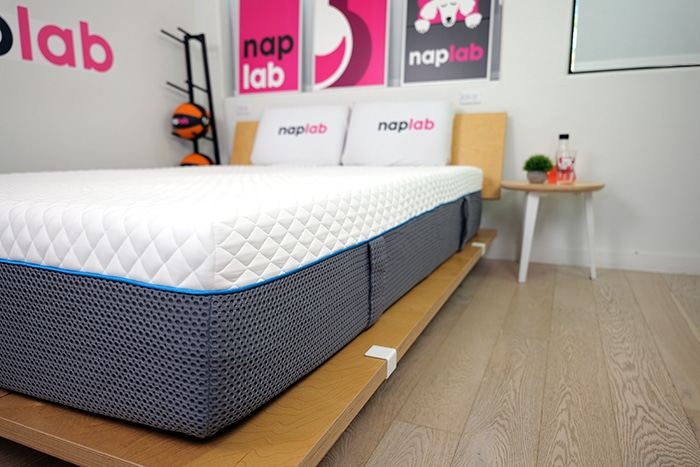
Cooling Test
The Simba Hybrid Pro has a good level of cooling performance. During our tests, I felt a slight level of heat retention around my body, but it was nothing overly dramatic or anything I would describe as “hot”.
Baseline Temp.
78.5° F
Max Temp.
89.7° F
Ending Temp.
81.4° F
On the positive side, the mattress uses a 1.5” layer of microcoils. This layer serves as an air gap, provides some airflow, and is functionally a layer that simply isn’t going to retain heat. However, it is only 1.5” out of a 13.5” total mattress height.
All of the other layers are built from memory foam and poly foam. These foam layers are higher quality and breathe reasonably well. Even so, the mattress in its totality is still a mostly foam mattress.
Max Temp.
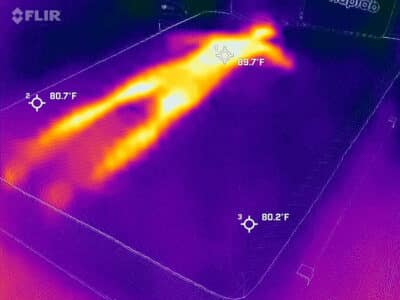
Ending Temp
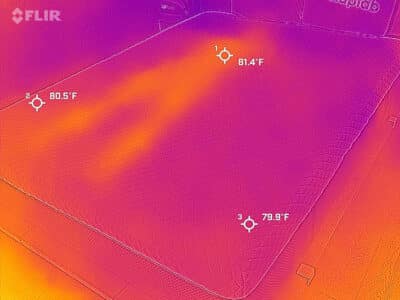
- Baseline Temperature – the temperature of the mattress before anyone lies on it
- Maximum Temperature (0 minute) – the temperature of the mattress after lying on it for 15 minutes
- Ending Temperature (5 minute) – the temperature of the mattress after being lied upon and having no one on it for 5 minutes
Foam mattresses tend to struggle more with heat retention compared to hybrid mattresses and other mattress types that contain higher profile coils.
In our objective temperature tests, we measured a max surface level temperature of 89.7° F, which is just 0.1° warmer than average.
After getting off the mattress, the temperature declined by 3.4° from minutes 0 to 1, which is 1.3° warmer than the average 0 to 1-minute decline of 4.7°.
Heat Dissipation Over Time
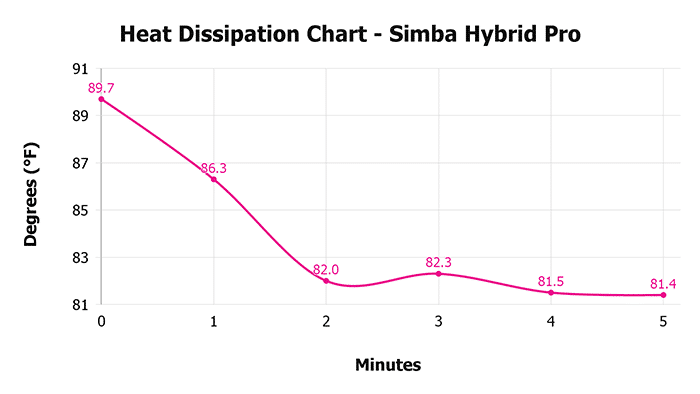
While I was pleased to see the objective max surface level temperature near the average, the worse-than-average 0 to 1-minute decline confirmed the subjective heat retention experiences on my body.
All that to say, cooling isn’t bad by any stretch, only that it could be better. Based on the objective data, my subjective experience, and analysis of the materials and design I’m confident in my view that cooling is good, but not great.
Sinkage Test
The Simba Hybrid Pro has a very deep level of sinkage. During our tests, we measured pressure point sinkage depth of 2.76”. This is 0.62” more sinkage than the average of 2.14”, based on all of our tests to date.
Sinkage Depth
2.76″
Sinkage Feel
Very Deep
Body Contour
Dramatic
The mattress creates a more dramatic body-contouring hug. The top 2.0” memory foam layer is really doing much of the heavy lifting.
That memory foam layer gives it a significant memory foam hug around the body. The microcoil layer below it compresses easily, allowing for deeper sinking into the mattress, further increasing the feeling of being “hugged”.
The level of sinkage is documented in the image below.

Many mattresses create more of a floating feeling where sleepers like “on” the mattress. This absolutely is not the case with the Simba Hybrid Pro. With this mattress, you lie “in” the mattress.
This is neither good nor bad, but it is a specific feel. Sleepers will really need to like a more significant contouring hug to be comfortable on the mattress.
Motion Transfer Test
The Simba Hybrid Pro has a low level of motion transfer. During our tests, we measured an acceleration range of 9.48 m/s². This is 8% more motion transfer than the average of 8.78 m/s².
Accel. Range
9.48 m/s²
Motion Duration
0.83 seconds
The mostly all-foam design is definitely helping to keep motion held to a minimum. However, the microcoil layer is likely increasing motion. Microcoils by their nature compress easily when weight is applied.
This creates an abrupt sinking into the mattress when sleepers get in and out of bed or change positions during the night. As a result, motion is low, but it’s not able to achieve the very lowest levels.
The level of motion transfer is also documented in the video below.
In our motion transfer chart, which visualizes our accelerometer data, we can see the highest motion peaks from 0 to 0.17 seconds. Motion drops significantly thereafter and by 0.83 seconds we’ve returned to near-zero levels of energy.
Motion Transfer Over Time

Ultimately, it’s really hard to complain about either motion intensity or motion duration here. Yes, there are mattresses that have less motion. However, motion at these levels is well-managed and should not be a problem for most sleepers.
Response Test
The Simba Hybrid Pro has a fast material responsiveness. During our tests, we measured a mostly recovered time of 0.5 seconds and a fully recovered response time of 0.8 seconds. This is 0.09 seconds and 0.10 seconds faster than the average responsiveness speeds of 0.41 and 0.90 seconds, respectively.
Mostly Recovered
0.5 sec.
Complete Recovery
0.8 sec.
The level of responsiveness is documented in the video below.
These response speeds are far from instant, but they aren’t slow either. The memory foam layer, combined with the deep level of sinkage, results in a combination that simply takes a moment to recover back to its original shape.
Even so, for most sleepers, this level of responsiveness will be perfectly satisfactory.
Bounce Test
The Simba Hybrid Pro has a low level of bounce. During our tests, we measured a total bounce height of 7.53”. This is 2.00” less bounce than the average of 9.53”, based on all of our tests to date.
Max. Depth
6.10″
Max. Rebound
1.43″
Total Bounce
7.53″
The mattress has a design and material layering that absorbs energy, but doesn’t return much bounce. This is great for helping to reduce motion transfer. However, the lower level of bounce does make it more difficult to move around on the mattress and also dramatically negatively impacts sex performance.
Max. Sinkage Depth
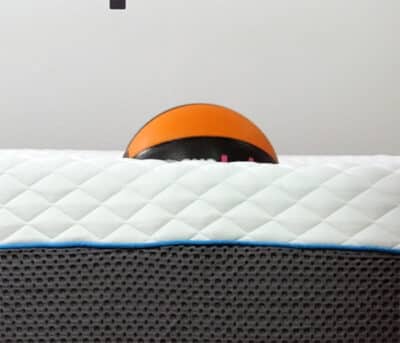
Max Bounce Height
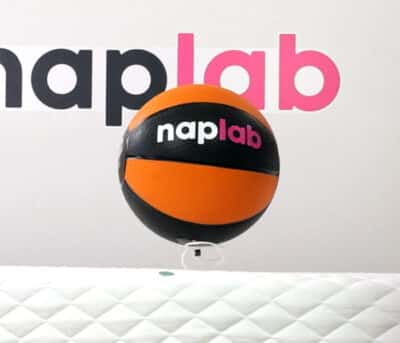
The level of bounce is also documented in the video below.
The microcoil layer allows for an easy and immediate deep level of sinkage into the mattress. However, those microcoils don’t spring back to shape like a typical coil unit is going to.
As a result, all of that energy that went into the bounce isn’t returned back. The layers of foam above and below the microcoil create some bounce back, but they aren’t significant. As a result, we measured a below average level of bounce on the Simba Hybrid Pro.
Edge Support Test
The Simba Hybrid Pro has poor sitting edge support, but excellent lying edge support.
Max. Sinkage
6.25″
Lying Support
Excellent
Reinforced Edge
No
In our sitting edge support tests, we measured a sitting sinkage compression of 6.25”. This is 2.21” more sitting compression than the average of 4.04”, based on all of our tests to date.
At 6.25” of sinkage the mattress just isn’t tremendously supportive while sitting directly on the edge. The same material and design aspects that create deeper sinkage, more hug, and lower motion are also a factor in the weaker sitting edge support.
The level of edge support while seated is documented in the images below.
Sitting, 140 lbs.
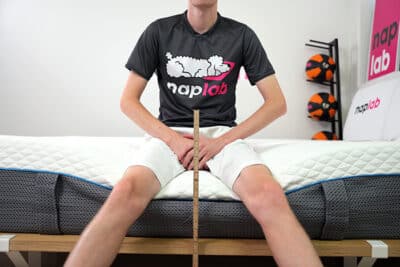
Sitting, 200 lbs.
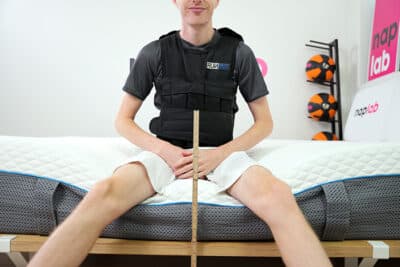
While edge support for sitting leaves much to be desired, I was far more pleased with the level of lying edge support. While lying directly on the edge of the mattress I felt well supported in all sleeping positions.
The level of edge support while lying is documented in the images below.
Lying on Edge, 140 lbs.
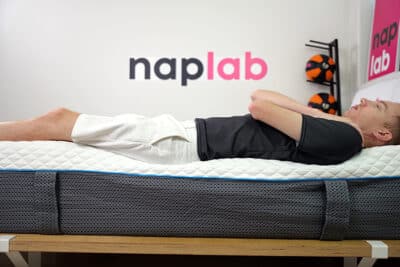
Lying on Edge, 200 lbs.
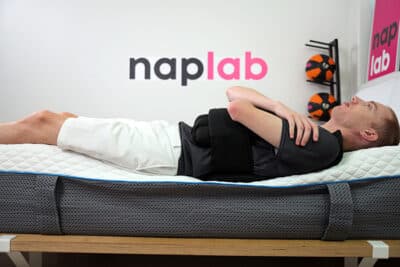
The mattress uses 4.0” of support foam that wraps around the entire perimeter of the mattress. This foam, coupled with a 7.5” support foam base, creates the right material conditions to deliver excellent edge support while lying.
Sex Test
The Simba Hybrid Pro has fair sex performance. On the positive side, noise is minimal, pressure relief is excellent, and cooling is good (even if it’s not quite great).
That said, bounce and edge support just aren’t strong performers. In our bounce tests, we measured 7.53” of total bounce height. This puts it on the bottom 23% of all mattresses we’ve tested to date.
| Sex Factor | Factor Weight | Score | Rating |
|---|---|---|---|
| Bounce | 65% | 7.2 | Moderate |
| Edge Support | 20% | 5.9 | Poor |
| Noise | 5% | 10 | Minimal |
| Pressure Relief | 5% | 9.0 | Excellent |
| Cooling | 5% | 8.0 | Good |
Ultimately, the mattress just doesn’t create enough bounce to facilitate ideal amorous activity conditions. Edge support is a similar story with 6.25” of sitting sinkage compression.
This puts sex performance in the bottom 5% among all mattresses tested to date.
Given the level of edge compression, it makes it incredibly difficult to use the edge of the mattress for dancing with pants. All factors considered, the Simba Hybrid Pro leaves much to be desired for sex.

Pressure Relief Test
The Simba Hybrid Pro has excellent pressure relief. During our tests, I felt no significant pressure points anywhere on my body. Overall, I found the mattress to be quite comfortable.
Comfort Layer
6.0″
Support Layer
7.5″
The mattress is equipped with a 6.0” comfort layer. This layer consists of 1.75” of memory foam, a 1.5” micocoil unit, and a 1.75” poly foam layer. Having the 1.75” memory foam on top creates fantastic pressure relief and body contouring hug.
In addition, the microcoil layer allows for a deeper level of sinkage, amplifying the feel and hug of the memory foam on top.

Based on all of our mattress tests to date, the average comfort layer thickness is 4.0”. Simba’s Hybrid Pro is 2” thicker than the average comfort layer. That extra thickness, combined with the quality of the materials, is able to create the excellent pressure relief we experienced on the mattress.
In our pressure mapping tests, we measured a max PSI of 1.08. This is a very low level of pressure. A PSI of 2.0 is considered high pressure and we are no where near those levels. In all 3 of our pressure mapping tests, we don’t see any significant pressure points building anywhere on the body.
Overall, I’m pleased with the pressure relief performance. I expect most sleepers will find pressure relief to be perfectly sufficient.
Pressure Map – Side Sleepers

| Pressure Relief (PSI) | Average | Maximum |
|---|---|---|
| Side Sleepers | 0.20 | 1.04 |
Pressure Map – Back Sleepers

| Pressure Relief (PSI) | Average | Maximum |
|---|---|---|
| Back Sleepers | 0.09 | 0.70 |
Pressure Map – Stomach Sleepers

| Pressure Relief (PSI) | Average | Maximum |
|---|---|---|
| Stomach Sleepers | 0.11 | 1.08 |
Off-Gassing Test
Off-gassing on the Simba Hybrid Pro is strong right tout of the box and the odor lasted for 7 days.
Initial Smell Strength
Strong
Off-Gassing Period
7 days
Comparing all mattresses tested to date (over 265+), this performance is right on par with the average off-gassing period.
Company
Simba offers a 100-night trial and a 10-year warranty on all of their mattresses. Shipping is free, but the only option to return your mattress is to exchange it with a $99 fee.
| Company Factor | Factor Weight | Score | Data |
|---|---|---|---|
| Returns | 40% | 0.0 | No / Very limited returns |
| Trial Period | 30% | 8.0 | 100 nights |
| Warranty | 20% | 8.0 | 10 years |
| Shipping | 10% | 10 | $0 |
| Country of Origin | 0% | Canada |
With the recent change to only being sold at Sleep Country, you can only exchange the mattress, and there are no returns offered. Additionally, there is a $99 exchange fee if you choose to go through the process.
Only allowing exchanges with a return fee doesn’t favor the consumer. It reduces the level of confidence one might have when purchasing a mattress, as you are locked into limited options for returns.
Compared to mattresses tested to date, this trial is shorter than the average (177 nights) and the warranty is also shorter—25% have lifetime warranties and the average of the other 75% of mattresses is a 13-year warranty.
How firm is Simba Hybrid Pro?
The Simba Hybrid Pro has a medium feel with a firmness of 5 out of 10, where 10 is the most firm.

Support & Sleeping Positions
The Simba Hybrid Pro has excellent support. During our tests, I felt well-supported in all sleeping positions. The mattress is equipped with a 7.5” support foam.
| Support Factor | Data |
|---|---|
| Comfort Layer | 6.0″ |
| Support Layer | 7.5″ |
| Firmness | Medium |
| Body Contour | Dramatic |
| Zoned Support | Yes |
| Reinforced Edge | No |
This is just a touch thinner than the average support layer thickness of 7.9”, based on all of our tests to date.
Despite this fact, the mattress did not feel lacking in any respect when it came to support.
The support foam is zoned with cut channels. These zoned sections within the foam help create a more appropriate level of support for your body based on where the body needs more or less pushback.
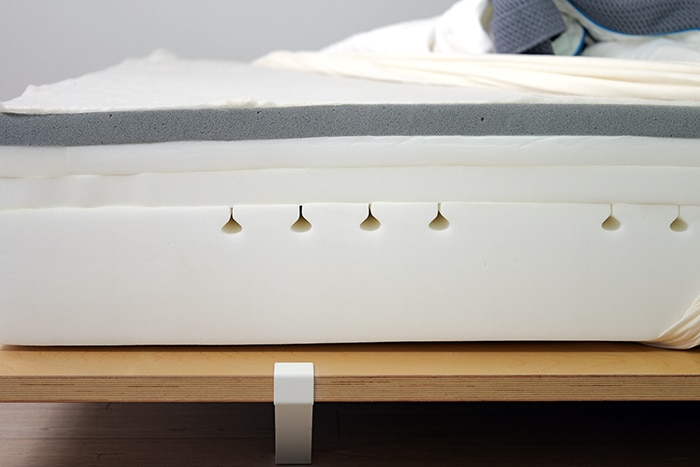
Lastly, the mattress uses a 4.0” foam that runs along the entire perimeter of the mattress. This perimeter run layer helps the edge of the mattress to feel considerably more supportive for lying on the edge.
Given the material thickness, material quality, and layered design, I’m confident most sleepers will find support to be more than sufficient.
Check out the table below to see the sleeper weights and sleeping positions that would be best suited for this mattress.
| Sleeper Weight | Stomach Sleepers | Side Sleepers | Back Sleepers |
|---|---|---|---|
| Under 150 lbs. | Yes | Yes | Yes |
| 150-250 lbs. | Yes | Yes | Yes |
| 250-300 lbs. | Yes | Yes | Yes |
Design
The Simba Hybrid Pro is a 13.5″ mattress made of foam, a small layer of microcoils, and a support foam base. It has a medium feel, 5 out of 10 on the firmness scale.
| Design Factor | Data |
|---|---|
| Type | Foam |
| Thickness | 13.5″ |
| Cover Type | Quilted |
| Weight | 84 lbs. |
| Has Handles | Yes |
| Fiberglass-Free | Yes |
| Ships in a Box | Yes |
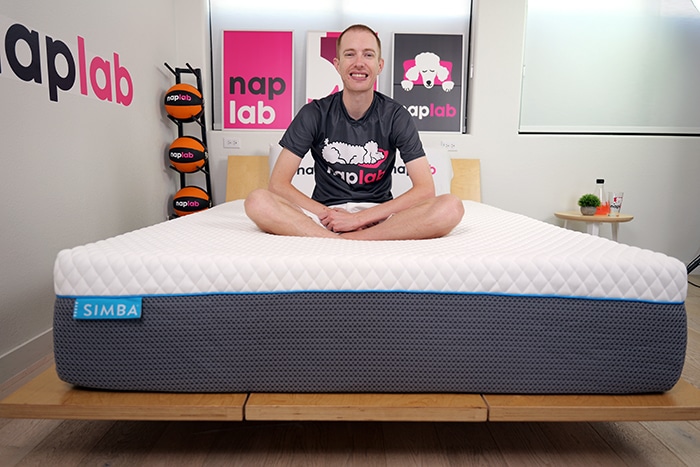
Simba called this a hybrid, but as mentioned above, that title feels like a bit of a stretch here.
Traditional hybrid mattresses have a foam comfort layer with a tall coil support base (typically 6-8″). But on the Simba Hybrid Pro, we’re seeing foam in the comfort layer and the support layer. The only use of coil is a small microcoil layer that’s 1.5″ thick.
Materials
From top to bottom, there are four layers that make up the Simba Hybrid Pro. Those layers include:
| Layer Type | Thickness | Layer Specs |
|---|---|---|
| Memory Foam | 1.75″ | Not Available |
| Microcoils | 1.5″ | Not Available |
| Poly Foam | 1.75″ | Not Available |
| Support Foam | 7.5″ | Not Available |
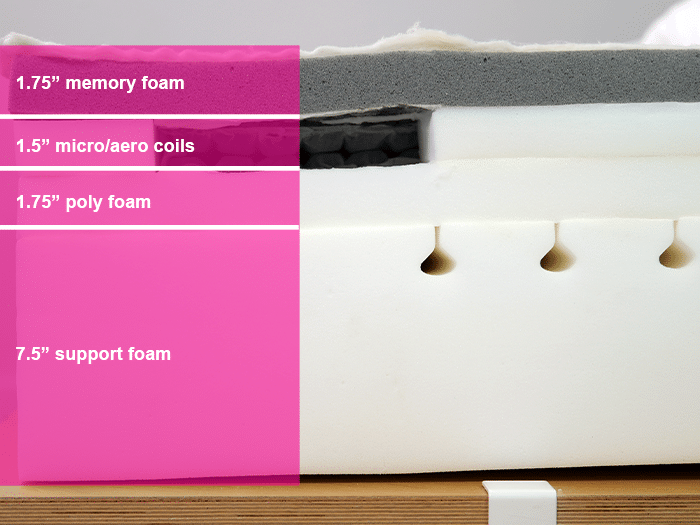
The models seem to be differentiated partially by the number of hybrid coils/springs. This hybrid pro model has 5000, while the essential model only has 1500. The product page makes a big deal of this number.
The Law Tag outlines the full breakdown of materials included in this mattress.
- Materials:
- Polyurethane foam 78.6%
- Micro coils/spring 17.7%
- Continuous filament silica & cellulose glass free cotton 3.7%
- Made For: Simba Sleep Ltd. 5th Floor Halo Counterslip Bristol/United Kingdom BS1 6AJ
- Date of Manufacture: 06/28/2023, or 03/11/23, or 07/17/2023
- Manufactured by: VPC Group Inc. 150 Toro Road, Toronto, Canada, M3J 2A9
- Finished Size: 59.5” x 79.5”
- Net weight of filling material: 83.5 lbs
- Made In: Canada
- Model: Simba 5000
- Big Sky Bedding Consulting 7306 SW 34th Ave. STE 373 Amarillo, TX 79121
The Cover
The Simba Hybrid Pro has a 1.0″ cover with a thin layer of cotton. It is quilted and has a small amount of stretch to it.
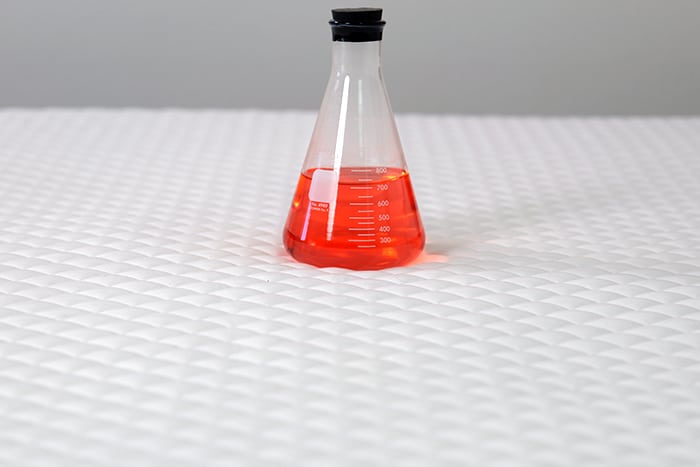
A layer of natural blended wool provides some loft to the cover for breathability and temperature regulation.
The Comfort Layer
There are two layers of foam and one layer of microcoils. The top is a 1.75″ memory foam followed by the 1.5″ high microcoils.
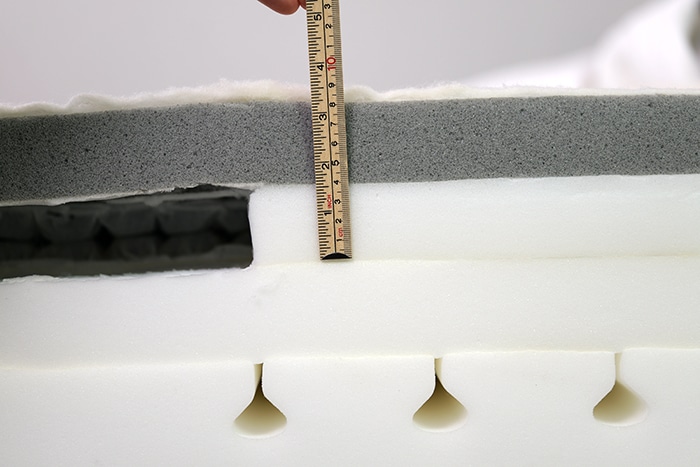
The perimeter of the mattress conceals the microcoils with a 2.5” perimeter support foam. This perimeter foam is located right below the memory foam layer (gray) and is 2.0″ thick.
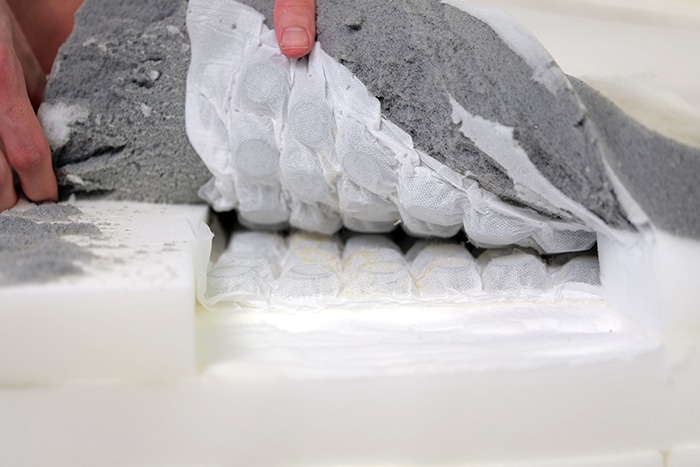
Below the perimeter foam and microcoils is a 1.75″ poly foam. The poly foam layer has a softer feel than the memory foam and does a nice job of providing transitional support.
The Support Layer
The support foam of the Hybrid Pro is a 7.5″ high-density foam. It is the bottom layer of this mattress and provides a supportive base.
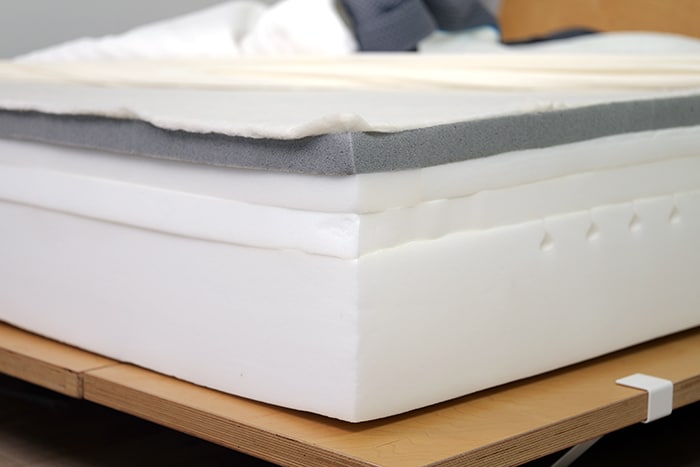
Product Evolution
The Simba Hybrid Pro was released in 2024. Since it launched, there have been no major changes made to the mattress in design or material.
Other Mattresses to Consider
Not sure if the Simba Hybrid Pro is the right pick for you? Check out these three other top-rated foam mattresses for high-performing alternatives you may want to consider.
For Performance
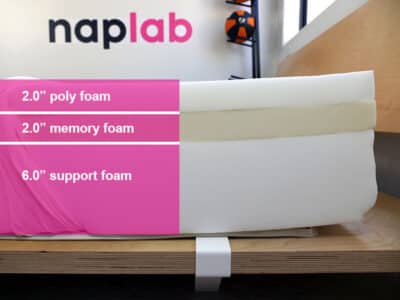
Leesa Original
Poly Foam + Memory Foam
The Leesa Original is a 10″ foam mattress with a comfort layer made of poly foam and memory foam. Leesa ties or outperforms the Simba in all 8 testing categories we score for.
For Poly Foam

Nolah Signature
12″ Thick All-Foam Mattress
The Nolah Signature is a 12″ foam mattress that skips the memory foam and exclusively uses poly foam for with the comfort layers. It has less sinkage, but a similar medium feel.
For Budget

GhostBed Classic
Deep Sinkage + Low Bounce
The GhostBed Classic is an 11″ foam mattress with a similar feel to Simba—deep sinkage and low levels of bounce. It is a tough firmer (6 out of 10 on the firmness scale). Priced at $842, the GhostBed is a great value mattress—less than half the price of the Simba Hybrid Pro.
Frequently Asked Questions
Still have questions? Check out some of the top FAQs on the Simba Hybrid Pro mattress below and get the answers you’re looking for.
Here are the current prices, with any sales or promotions reflected below:
Twin: $1,339
Twin XL: $1,499
Full: $1,699
Queen: $1,799
King: $2,099
Cal. King: $2,099
*Note: Sales prices are subject to change without notice or warning.



